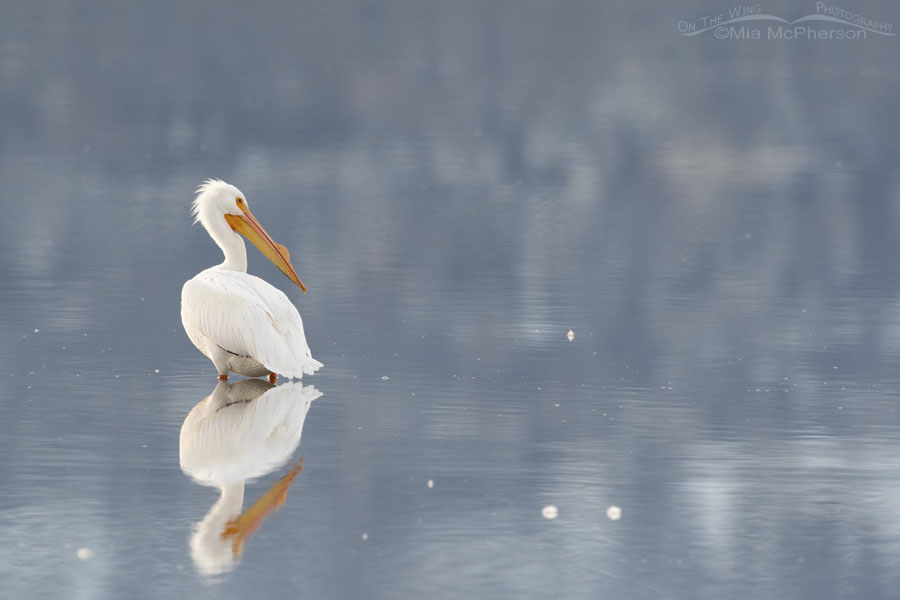 American White Pelican and Wasatch Mountain reflections – Nikon D500, f7.1, 1/250, ISO 500, Nikkor 500mm VR with 1.4x TC, natural light
American White Pelican and Wasatch Mountain reflections – Nikon D500, f7.1, 1/250, ISO 500, Nikkor 500mm VR with 1.4x TC, natural light
I drove up to Farmington Bay WMA yesterday morning because it looked like there was going to be some nice light and because the forecast for the next week looks rather dismal for bird photography. I’m so very glad I went because I was able to photograph my first of the year American White Pelicans. I’ve missed them, missed seeing them circling in large squadrons in the sky, missed seeing them feeding, and I’ve missed seeing their large white forms floating on the water at Farmington Bay WMA and Bear River MBR.
The very first birds I photographed were American White Pelicans so I decided they should be the first images I share here from my morning trip to Farmington Bay yesterday even though I can say for certain that the Bald Eagles that I photographed yesterday would garner more views.
I was driving south towards the four way when I saw this American White Pelican in the very shallow water of Unit 1, the sun still hadn’t come up high enough to light up the bird or the water but that allowed for a reflection of the Wasatch Mountains to show on the water. I felt I had to stop, turn off my Jeep and capture this image even though the pelican was some distance away and it would be small in the frame. This photo though is as much about the reflections as it is the pelican and the soft light seemed to not only accentuate the beauty of the bird it also conveys, at least to me, a sense of peacefulness.
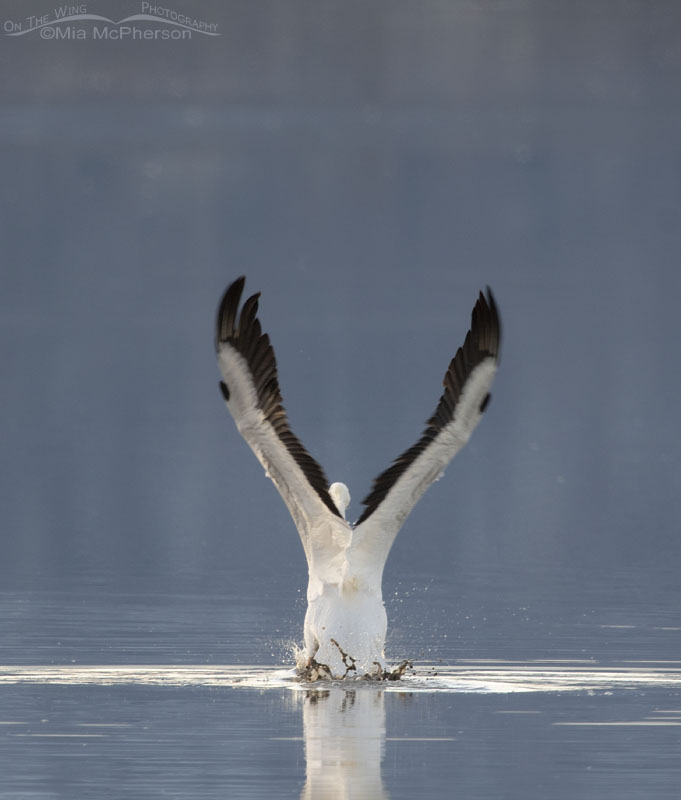 Rear view of an American White Pelican taking off – Nikon D500, f5.6, 1/400, ISO 500, Nikkor 500mm VR with 1.4x TC, natural light
Rear view of an American White Pelican taking off – Nikon D500, f5.6, 1/400, ISO 500, Nikkor 500mm VR with 1.4x TC, natural light
Then an immature Bald Eagle flew in over the pelican and it started flapping its wings to take off while I continued to photograph it. I like how the feet of the pelican stirred up dark mud from beneath the shallow water and can be seen beneath the pelican’s tail. What caught my eye in this frame though are all of the black primary and secondary feathers of the pelican’s wings and the spots that the black alula feathers created when the pelican’s wings were fully extended. I’m not sure I’ve ever noticed this pattern before but I generally don’t try to take images of birds flying away from me.
I made a mental note to myself to take butt shots more often.
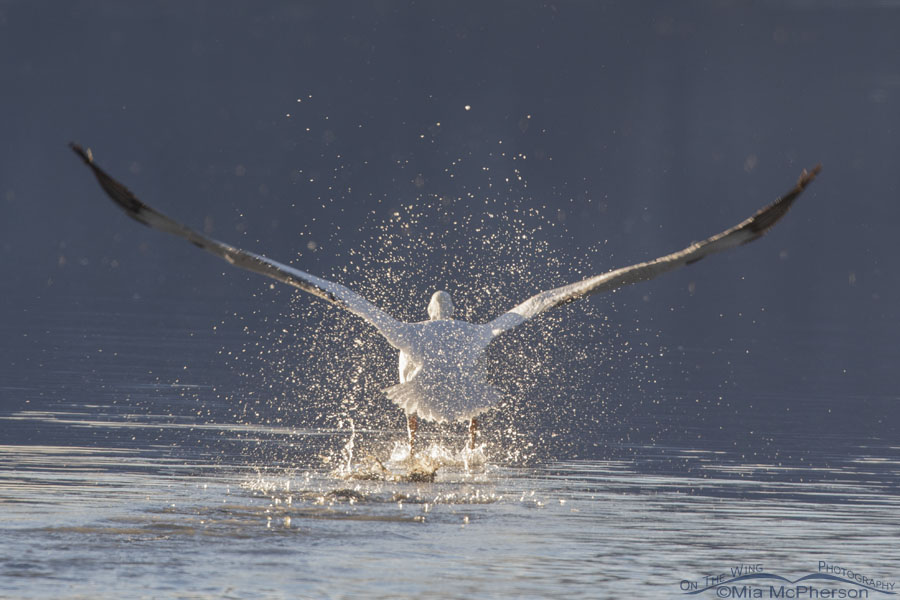 American White Pelican splashing while taking off – Nikon D500, f7.1, 1/500, ISO 500, Nikkor 500mm VR with 1.4x TC, natural light
American White Pelican splashing while taking off – Nikon D500, f7.1, 1/500, ISO 500, Nikkor 500mm VR with 1.4x TC, natural light
So, I paid attention to the mental note I made to myself and took more butt shots of some pelicans further down the road that were also taking flight.
This pelican was taking off in a spot where the sun had lit it up but was right on the edge of the shadow of the mountains so even though the exposure on the bird was okay the splashing water lit up and showed as a bright white in the frame. I know that this image might not be appealing for everyone’s tastes because it is a rear view of the bird and that bright water might be distracting but I take images for myself and I find this photo visually stimulating and appealing.
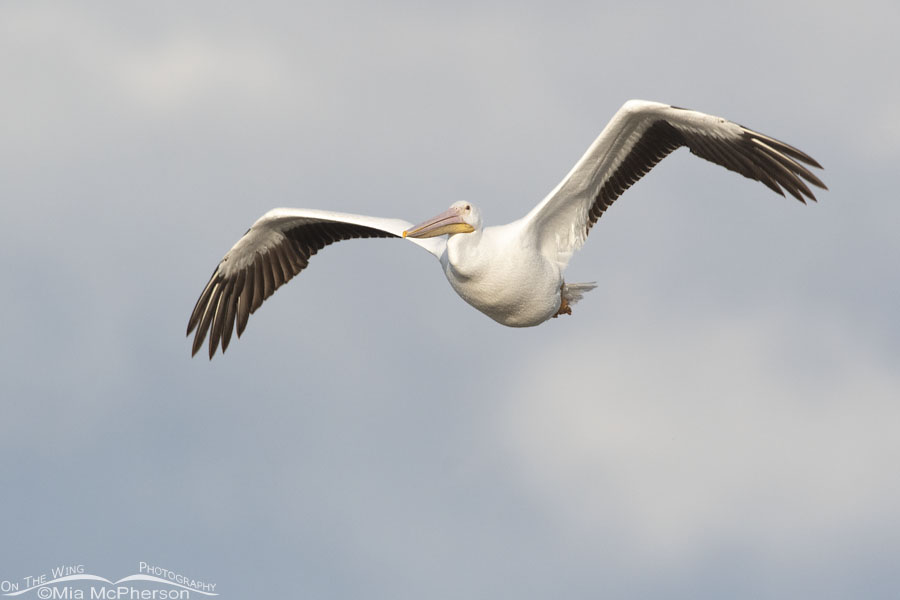 February American White Pelican in flight – Nikon D500, f7.1, 1/2500, ISO 800, +0.7 EV, Nikkor 500mm VR with 1.4x TC, natural light
February American White Pelican in flight – Nikon D500, f7.1, 1/2500, ISO 800, +0.7 EV, Nikkor 500mm VR with 1.4x TC, natural light
Later on in the morning as I sat in my Jeep watching and photographing Bald Eagles I also photographed the other birds that came within range and that included more American White Pelicans that flew past. Since this American White Pelican does not have a projection (aka horn, caruncle, fibrous plate) on its bill like some of the other American White Pelicans I photographed yesterday it may be that it hatched last year and won’t develop breeding plumage this season. I’ve read that it can take up to three years for these pelicans to mature enough to breed.
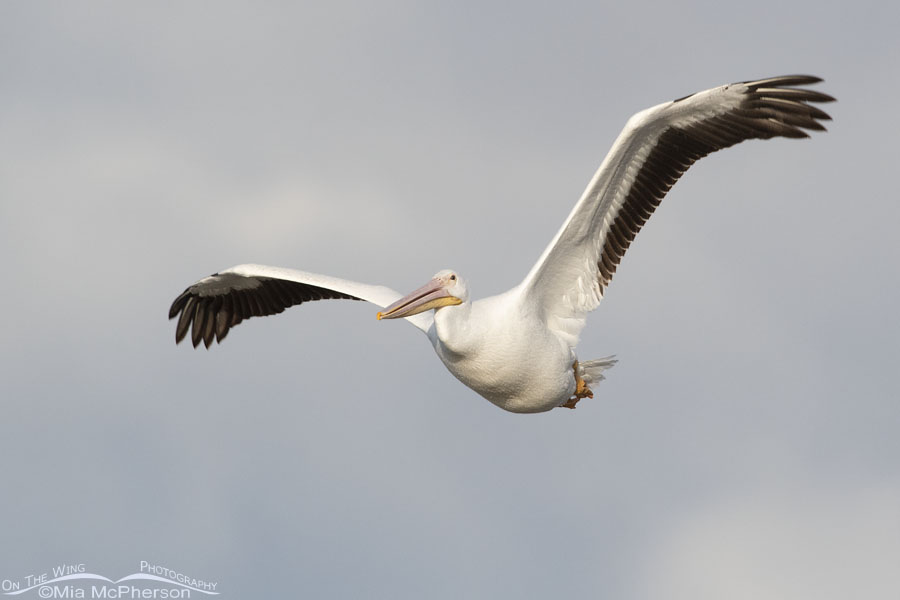 American White Pelican in flight in a winter sky – Nikon D500, f7.1, 1/2500, ISO 800, +0.7 EV, Nikkor 500mm VR with 1.4x TC, natural light
American White Pelican in flight in a winter sky – Nikon D500, f7.1, 1/2500, ISO 800, +0.7 EV, Nikkor 500mm VR with 1.4x TC, natural light
The American White Pelican was close enough that I was able to take a nice series of images of it as it flew past me, over the road and towards the water to the east.
It felt like spring yesterday at Farmington Bay WMA because of warmer temps plus the blackbirds and sparrows were calling and I had my first of the year pelicans in my view. I felt so very relaxed that I wanted to sit right there all day long. It got to 52°F at home yesterday but the temps dropped rapidly before dusk and not long after that the snow started falling again. The brief glimpse I had of spring yesterday was delightful but ole man winter hasn’t left Utah yet.
More photos from my trip yesterday to Farmington Bay WMA to come.
Life is good.
Mia
Click here to see more of my American White Pelican photos plus facts and information about this species.


Spectacular shots! All of them!
You really captured the gravity of the birds in the air. They’re like flying tanks!
Wonderful shots!!! Love the butt shots, especially because they give information about the bird that is too often missing…I can remember painting a bird called Winston,trying to find a butt shot of the darned GHO that was sitting back to me, head turned toward me…couldn’t get him to cooperate, always faced me…so no photos of his back.
Beautiful photos, the morning was stunning yesterday. I like the black spots on the wings, I have not noticed that before.
I would say it is a fist year pelican due to the pink colored bill it still has and they eye looks dark.
Wow, wow and wow.
I do love pelicans and am always amazed at just how much of their dinosaur ancestry remains evident.
Love seeing the alula, unexpectedly black. Made me think . It must be that because the alula is part of the “flight system”, then it should have the stronger black feathers for flight.
And, photo #3 is really engaging, visually, and it also made me think. My immediate impression was that the pelican had shaken itself to get rid of water…..My brain needed a few seconds to “get with the picture”!
I love to be drawn into the picture and feel like I’m there.
Thank you, Mia!
I find the two “butt shots” very appealing for the exact reasons you described. Plus, there’s something special about watching Pelicans of any species in flight. We have Brown Pelicans year round here and I love seeing them.
Love the pose and reflection in the first image.
Super photos
WOW!!!